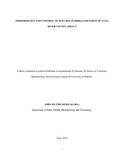| dc.description.abstract | Irrigation schemes introduced in areas of high malaria endemicity often amplify malaria burden especially if no mitigation or adaptation measures are implemented. The development of Bura and Hola irrigation schemes (to enhance food security) in Tana River County, Kenya, might have escalated the baseline risk of the disease in the area. The objectives of this study were to: (i) assess the knowledge, attitude and practices (KAP) of the local communities in relation to malaria transmission and control; (ii) determine the prevalence of malaria and the associated risk factors; and (iii) develop and validate a deterministic model for analysing the effects of irrigation
on malaria transmission. A cross sectional study was conducted in Bura irrigation scheme between November and December 2013. A total of 48 questionnaires were administered to the household heads to collect
information on KAP and potential risk factors of malaria. Concurrently, 160 people (maximum of five people randomly selected from each of the 48 households) were screened for malaria parasites using Rapid Diagnostic Test (RDT). A dynamical model made up of mosquito population module and disease transmission module was developed and validated using field data on the amount of water per unit area of irrigated land, rainfall and temperature and then fitted to the observed malaria prevalence data. The Entomological Inoculation Rate (EIR) was
then estimated. The community in Bura irrigation scheme demonstrated good knowledge on causes, symptoms,
transmission and control of malaria. Almost all (98%) of the interviewed households owned at least one bed net, and 93% of them had their nets treated with an insecticide. The average number of nets per household was three (one net for every two people) with 98% of the household members reporting having used the net the night before the interview. Sources of the mosquito nets included government health facilities (69%), government campaign (19%), NGOs (19%) and the rest, through purchasing. Only 12% of the households practiced environmental management to control malaria transmission. Treatment of clinical cases was based on
Artemether-lumefantrine (AL) which is freely available in the government health facilities. The prevalence of malaria at the community level was 5% while a review of clinical records indicated a decline in the prevalence. Households located ≤5kms from the nearest health facility had a lower risk of malaria infection (OR=0.104, p-value=0.0128) than those located >5kms. Household size was also associated with malaria infection (OR=1.685, P-value=0.0226). The model reproduced the observed prevalence data with a variance of 0.0002. The estimated EIR was five infectious bites per person per year. This study showed that the high usage of Insecticide Treated Nets (ITNs) and Artemetherlumefantrine (AL) could have led to a decrease in malaria prevalence in irrigated parts of Tana River County despite the intensification of irrigated agriculture. This means that a larger
population in this area is becoming susceptible to malaria infection suggesting the possibility of an epidemic if the current interventions are not sustained. Awareness should be created on the importance of integrated management of malaria. The developed model could be used to predict the prevalence of malaria in this area enabling decision makers to implement appropriate control measures in a timely manner. Data from non-irrigated areas and covering a longer period of time should be collected for more rigorous model validation and simulation of the effectiveness of various interventions. | |

